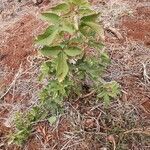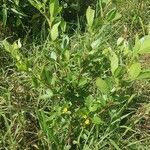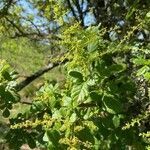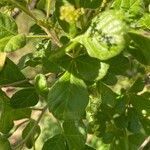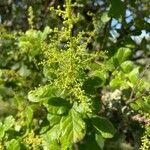A plant which varies a lot. It can be a shrub or a tree. It is spreading. It can be 5 m tall. It is frequently spiny. The bark is dark brown. The young stems are green. They often have rusty velvet hairs and stout spines. It can be evergreen or lose its leaves in the dry season. The leaves have 3 leaflets. The leaflets vary in shape. The end leaflet can be 3-8 cm long by 1-2.3 cm wide. The side leaflets are shorter. The leaves are dark green on both surfaces and have a white covering of hairs. Male and female flowers are on separate plants. The flowers are very small and yellow. The occur in heads at the ends of branches. These can be 20 cm long. The fruit is 4-5 mm across. They are red when mature. There are several varieties.
Tree or shrub, 0.5-6.0 m high; multi-stemmed, unarmed or armed; bark grey, granular; branchlets pendulous, puberulous, occasionally parasitised with spherical galls. Leaves petiolate, trifoliolate; leaflets submembranous to subcoriaceous, dull olive-green above, paler below, puberulous to sericeous above, villous below, elliptic to obovate, margins entire, rarely with 1 or 2 indentations, slightly revolute. Inflorescence axillary panicles, up to 70 mm long, terminal up to 100 mm long, puberulous to villous. Flowers pedicellate to subsessile; pedicels and calyx hairy. Flowering time Oct.-June. Fruit a drupe, circular, globoid, glabrous, dull yellow to reddish, drying dark brown.
Dioecious, deciduous, armed shrub or small tree to 6 m. Leaves trifoliolate, leaflets sessile, obovate, often hairy. Flowers pale yellow. Drupes round, smooth.
